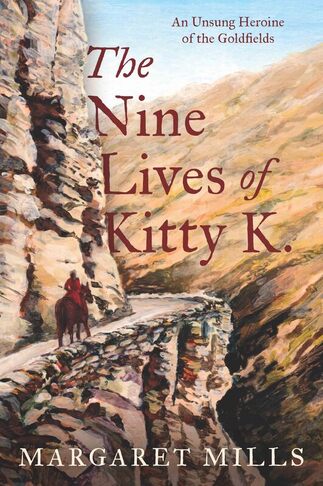
An Unsung Heroine of the Goldfields
by Margaret Mills
This, the life story of a South Island identity, can be read as an allegory. Arriving as a baby in the Otago of 1856, ‘Kitty’ Cameron owes her past to the moral taboos of the Old World and her present and future to the mores of the New. Her pregnant mother, Catherine, is forced into marriage with a homosexual relative of the baby’s nobly-born father and sent to the colonies on remittance, thereby removing three embarrassments to the family at one blow.
Catherine proves remarkably resilient as both mother and dairymaid after the planned disappearance of her husband, and manages to see out Kitty’s early years in the young colony of Dunedin before taking up with would-be farmer George Kirk and moving with a now ten-year-old Kitty to Wakatipu.
Adept with animals of all sorts, Kitty’s life is lived out in the Wakatipu, thereafter between Kinloch and Fairlight and, even as she grows, marries and starts a family, she maintains a near-legendary status as a horsewoman. She is cursed in areas of personal relationships and essentially marries to escape an acrimonious relationship with her mother, who never gives up her Old-World determination to get her spirited daughter to ‘know her place’ in the world despite an elevation to the status of landowner that would have been impossible for Catherine herself in her native Ireland.
Sadly, Kitty’s choice of husband isn’t a good one, and John Greig emerges as a controlling bully with a drinking problem, but the clarity of his depiction tells the reader a good deal about the social attitudes of miner society. Tragedy also haunts Kitty in the loss of three of her children and the estrangement of a fourth consequent on her decision to leave the unhappy marriage and, after a brief interlude in a happy relationship, she ultimately enters a downward spiral that is better read about than described because of what it leaves unsaid about Kitty.
At several places the book offers good and valid glimpses of life, manners, morals and expectations in 19thcentury New Zealand’s mining societies, but the first point to be made about it is that, at over 150,000 words it is over-long. In part this is because, up to “Life” 4, Kitty’s story is a construct unfounded on fact, and while the author has undoubtedly researched widely to create what is basically a novel to that point, she has given way to the temptation to include all of it. An outstanding example of this is the inclusion of the life and disappointments of ‘Mr Rees’, which a reader struggles to accept as necessary. Sometimes, knowing what to leave out is just as important as knowing what to put in, and aspects of the work badly need the sort of editing that keeps a story moving and buoyant.
As contrast, the story from “Life” 5 onwards is much tighter and closely-drawn, and it is no coincidence that the references listed by the author appear to date from that point of the story. It is also not without significance that the person who appears to have been the architect of Kitty’s story, Mary-Jane Mulholland, appears in it at that time. It’s hard to avoid the conclusion that Kitty’s story ought to have begun at Life 5 when, with sympathetic editing, the back story that currently takes up some 50,000 words could have been expressed in many fewer.
Part of the problem in writing about the past is the necessity of avoiding anachronism. Halfway through the 19th century, people did not ‘sign off’ on documents, nor did they ‘take his answer on board’. Life did not ‘just get a whole lot better’, and if anyone was ‘blown away’ it was probably by explosives and not by the beauty of Lake Wakatipu.
Consistency of character underpins a story for a reader, and while we learn that the tomboy Kitty is unusually mature for her years in thought and vocabulary, by the same token it is unfortunate that the Catherine established early on as capable and resilient becomes a person who dissolves in tears at each and any setback.
As in any work of history, though, seeing events through the eyes of the people of the time only enhances the experience and promotes understanding, and none of the technical issues mentioned in connection with “The Nine Lives of Kitty K . . .” detract significantly from its contribution to a much-needed and important body of New Zealand literature.
Author: Margaret Mills
Publisher: Mary Egan Publishing
ISBN: 9780473542030
RRP: $34.95
Available: paper: bookshops

 RSS Feed
RSS Feed
